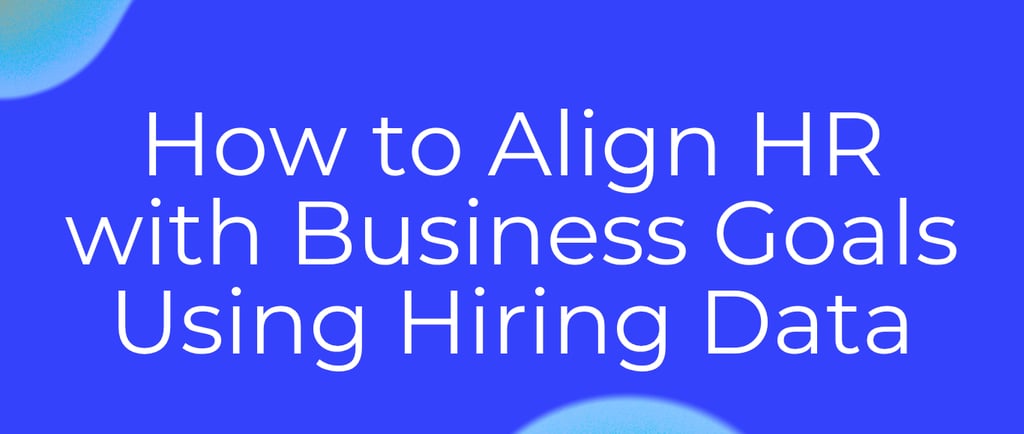How to Align HR with Business Goals Using Hiring Data
Discover how HR teams can leverage hiring data KPIs, predictive metrics, and performance insights to drive strategic impact and align with business outcomes.
Yeli Peña
10/16/20253 min read


How Can HR Prove Its Value in Business Terms?
If HR wants a seat at the strategic table, it must speak the language of the business—outcomes, speed, cost, and ROI. That means moving beyond administrative tasks to become a data-driven decision-maker.
Hiring data is the bridge.
In this guide, we’ll show how talent teams can use recruitment analytics to influence executive strategy, gain cross-functional buy-in, and prove the value of HR in high-impact business terms.
The Common Disconnect Between HR and Business Strategy
When the business wants growth, finance thinks budgets, operations think timelines—but HR is often left reacting instead of leading.
Why?
Because HR still relies too much on intuition instead of insights.
Outdated tools, inconsistent processes, and unclear metrics can make it hard to connect talent strategy to bottom-line results. When that happens, HR’s influence shrinks—especially during key moments like budgeting, workforce planning, or expansion.
But when HR teams start showing how recruitment metrics affect performance, everything changes.
From “HR Activity” to “Business Impact”
To align with business goals, HR must move beyond tracking actions (e.g., how many interviews were done) to measuring outcomes (e.g., how hiring delays impacted revenue).
Here are three essential types of hiring data that shift perception and unlock strategic influence.
1. Operational Efficiency Metrics
These help demonstrate how hiring speed affects execution and time-to-market.
Time-to-fill
Time-to-interview
Offer acceptance rate
Why it matters:
Hiring bottlenecks delay project launches, client onboarding, and store openings. By tracking these metrics, HR can spotlight how process inefficiencies slow growth.
2. Quality & Performance Metrics
Go beyond the hire. Show how the right hire drives long-term success.
Retention at 3, 6, and 12 months
Time-to-productivity / Ramp-up speed
Manager satisfaction (via post-hire surveys)
Why it matters:
Turnover and underperformance are expensive. These metrics help tie recruitment quality to cost-of-turnover and operational continuity.
3. Predictive & Forecasting Indicators
Use analytics to anticipate issues before they disrupt operations.
Pipeline coverage vs. forecasted demand
Candidate drop-off rate by funnel stage
Conversion rate by source/channel
Why it matters:
Predictive hiring data helps HR justify budget, headcount, or technology investment before gaps impact performance.
Real-World Example: Hiring Data in Logistics Staffing
One Nova Hiring customer in the logistics space was struggling to fill warehouse shifts on time. By analyzing their recruitment data, they found:
Slow screening was delaying placements
No-show rates were higher than expected
Their current tools weren’t built for speed
What they did:
Presented forecasted ROI of automating screening
Justified a tech upgrade based on candidate drop-off metrics
Secured budget by linking delays to operational costs
Results:
36% faster placements
2x increase in shift fill rate
HR went from being a bottleneck to a growth enabler.
How to Get Started: 4 Steps to Turn Data Into Strategy
Step 1: Align With Business Leaders
Start with a simple question:
“What are the top three things slowing down your team right now?”
Use those answers to identify where hiring metrics could provide visibility or support.
Step 2: Choose 3–5 HR KPIs That Matter
Focus on a few metrics that map directly to business outcomes—such as speed, quality, or cost.
Examples:
Time-to-fill for revenue-critical roles
Retention in departments with high turnover
Conversion rates for seasonal hiring campaigns
Step 3: Automate Reporting
Manual reporting kills momentum. Invest in dashboards, HRIS integrations, or ATS analytics to visualize trends and flag risks early.
Step 4: Translate Data Into Business Language
Use numbers that matter to leadership, such as:
“Reducing time-to-fill by 10 days saves $X in delayed project costs.”
“Improved retention adds $Y in productivity and lowers training spend.”
Add charts, stories, and forecasts. Speak in terms of cost, speed, revenue, and risk.
Hiring Data = Strategic Power for HR
You don’t need to revamp your entire HR tech stack to start influencing business strategy.
But by tracking the right metrics and presenting them through a business lens, HR teams can build trust, earn influence, and lead conversations at the highest levels.
At Nova Hiring, we help HR teams translate recruitment data into actionable business insights—so you can align, influence, and lead with confidence.
Navigation
Subscribe to our newsletter
AI-powered hiring automation: interview every candidate, hire faster, decide smarter.
Offices in Barcelona & Valencia
Nova Hiring 2025. All rights reserved.
Contact us


info@novahiring.com


